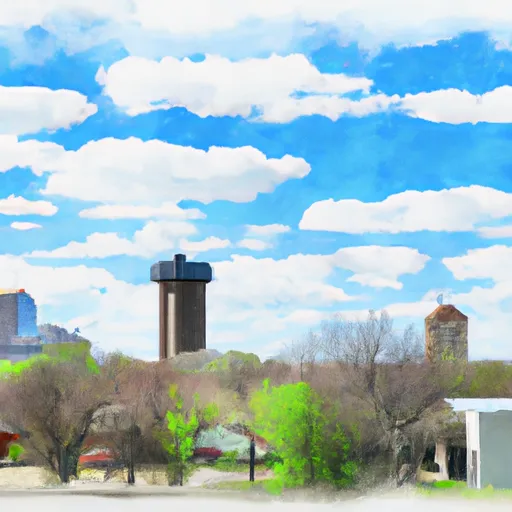-
 Snoflo Premium
Snoflo Premium
Get unlimited access to all our content
With no Ad interruptions! - Start Your Free Trial Login with existing account
Irving
Eden Index
Climate
8.3
•
Recreation
0.3
•
Community
•
Safeguard
3.4/10

Irving, Illinois is a small village located in Montgomery County, in the central part of the state. The climate in Irving is classified as humid continental, experiencing warm summers and cold winters. Average temperatures range from around 25°F (-4°C) in winter to approximately 85°F (29°C) in summer. Precipitation is fairly evenly distributed throughout the year, with an annual average of about 40 inches (102 cm), providing ample water resources for the area.
In terms of hydrology constituents, Irving is not situated near any major rivers or lakes. However, the village does have ponds and smaller streams that contribute to the local hydrological system. These water bodies support various wildlife species and provide opportunities for fishing and recreational activities.
Outdoor recreation enthusiasts can enjoy the serene natural surroundings of Irving. The area offers opportunities for hiking, bird-watching, and camping, with several parks and nature preserves nearby. Boating and fishing can be enjoyed in the local ponds and streams, providing a peaceful and relaxing outdoor experience for residents and visitors alike.
Overall, Irving, Illinois offers a pleasant climate, adequate water resources, and diverse outdoor recreational opportunities, making it an attractive destination for nature lovers and outdoor enthusiasts.
What is the Eden Index?
The Snoflo Eden Index serves as a comprehensive rating system for regions, evaluating their desirability through a holistic assessment of climate health, outdoor recreation opportunities, and natural disaster risk, acknowledging the profound impact of these factors on livability and well-being.
Climate Health Indicator (CHI): 8.3
Irving receives approximately
1012mm of rain per year,
with humidity levels near 81%
and air temperatures averaging around
13°C.
Irving has a plant hardyness factor of
6, meaning
plants and agriculture in this region thrive during a short period during spring and early summer. Most
plants will die off during the colder winter months.
By considering the ideal temperature range, reliable water supplies, clean air, and stable seasonal rain or snowpacks, the Climate Health Indicator (CHI) underscores the significance of a healthy climate as the foundation for quality living.
A healthy climate is paramount for ensuring a high quality of life and livability in a region, fostering both physical well-being and environmental harmony. This can be characterized by ideal temperatures, reliable access to water supplies, clean air, and consistent seasonal rain or snowpacks.
Weather Forecast
Streamflow Conditions
Kaskaskia
Area Rivers
Kaskaskia
Snowpack Depths
Kaskaskia
Reservoir Storage Capacity
Kaskaskia
Groundwater Levels
Recreational Opportunity Index (ROI): 0.3
The Recreational Opportunity Index (ROI) recognizes the value of outdoor recreational options, such as parks, hiking trails, camping sites, and fishing spots, while acknowledging that climate plays a pivotal role in ensuring the comfort and consistency of these experiences.
Access to outdoor recreational opportunities, encompassing activities such as parks, hiking, camping, and fishing, is crucial for overall well-being, and the climate plays a pivotal role in enabling and enhancing these experiences, ensuring that individuals can engage in nature-based activities comfortably and consistently.
Camping Areas
| Campground | Campsites | Reservations | Toilets | Showers | Elevation |
|---|---|---|---|---|---|
| Lake Walker Military - Camp Shelby | None | 239 ft | |||
| Big Creek Waterpark | None | 254 ft | |||
| Marathon Lake | 71 | 481 ft | |||
| McLeod Water Park | None | 22 ft | |||
| Shockaloe Base Camp I | 10 | 578 ft | |||
| Paul B Johnson State Park | None | 245 ft | |||
| Buccaneer State Park | 276 | 5 ft | |||
| Lake Ross Barnett | 22 | 402 ft | |||
| North Graysport - Grenada Lake | 51 | 279 ft | |||
| Little Black Creek Waterpark | None | 296 ft |
Nearby Ski Areas
Catastrophe Safeguard Index (CSI):
The Catastrophe Safeguard Index (CSI) recognizes that natural disaster risk, encompassing floods, fires, hurricanes, and tornadoes, can drastically affect safety and the overall appeal of an area.
The level of natural disaster risk in a region significantly affects safety and the overall livability, with climate change amplifying these risks by potentially increasing the frequency and intensity of events like floods, fires, hurricanes, and tornadoes, thereby posing substantial challenges to community resilience and well-being.
Community Resilience Indicator (CRI):
The Community Resilience Indicator (CRI) recognizes that education, healthcare, and socioeconomics are crucial to the well-being of a region. The CRI acknowledges the profound impact of these elements on residents' overall quality of life. By evaluating educational resources, healthcare accessibility, and economic inclusivity, the index captures the essential aspects that contribute to a thriving community, fostering resident satisfaction, equity, and social cohesion.

